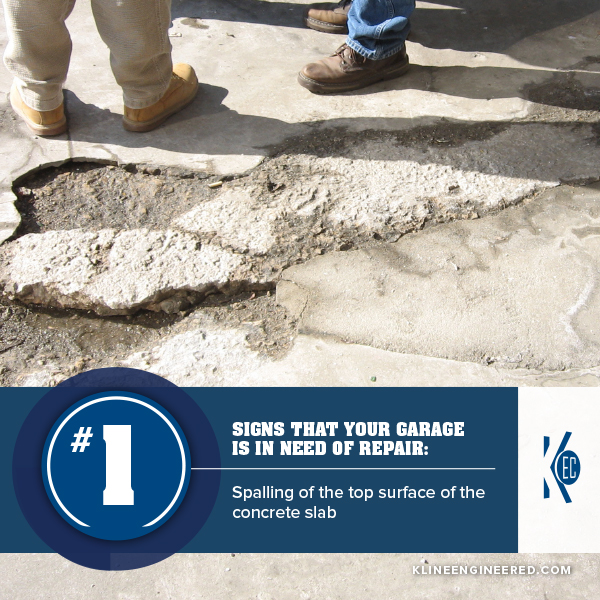8 Signs That Your Garage is in Need of Repair
At Kline Engineering, we have decades of experience identifying and repairing structural distress. But for property managers or owners, distinguishing between normal wear and tear in your parking structure and serious structural distress can be tricky. This is because symptoms of serious deterioration can often appear to be little more than cosmetic damage to the untrained eye. And misidentifying structural damage can quickly degrade the capacity and integrity of your garage!
Don’t panic! Learn to recognize some of the most common signs of structural failure and when in doubt, contact a professional.
Here are some tell-tale signs that your garage is in need of repair:
1. Spalling of the top surface of the concrete slab.
When embedded reinforcing steel corrodes, it expands to more than twice its original volume. This expansion creates tensile forces within the concrete surface leading to spalling and delamination of the concrete. This is an indication that the concrete passive layer (protective layer) has been degraded leading to corrosion of the embedded steel. Left unchecked, the durability of the concrete is severely degraded.
2. Exposed steel in the top surface of the concrete slab.
Concrete protects the embedded steel reinforcement from corrosion. Exposed steel indicates reduced concrete cover, which may be widespread, thus reducing the thickness of the protective concrete cover, leading to reduced durability.
3. Cracks large enough that water leaks through.
Cracks in concrete are caused by a variety of factors. You may have heard the statement “all concrete cracks”. Generally, this statement is correct; however, one must discern the difference between an acceptable crack and one that may lead to durability issues. Cracks that are large enough for water to leak through the deck should be repaired.
4. White mineral efflorescence hanging from cracks in the slab soffit (ceiling).
Efflorescence is the result of soluble salts migrating to the surface of the concrete where the water evaporates, depositing a whitish trail of crystalline salts. Efflorescence itself is harmless, but it is usually a sign that water is finding its way into the concrete. This can lead to corrosion of the embedded steel.
5. White efflorescence stains on the vertical faces of beams and slabs.
This can be a symptom of water infiltration into the post-tensioning system leading to corrosion of the PT. Left untreated, it can lead to failure of the PT system.
6. Grease stains not on the top of the slab, but on the bottom (soffit) of the slab.
The tendons within a post-tension concrete structure are protected from corrosion with grease and plastic sheathing. Visible grease stains on the bottom of a slab might indicate that the protection of the post-tensioning system has been breached.
7. Loose vehicular barrier cables.
Loose barrier cables indicate that the cable end anchors are failing. This is a serious safety risk as vehicles that impact the cables will not be restrained from falling. Several fatalities have occurred when vehicles have fallen from parking structures.
8. Ponding water on the top surface of the slab after rain or snow.
A properly constructed parking slab is designed to drain easily, but over time, the natural sagging or “creep” of a concrete structure can lead to ponding in new areas. This will lead to water damage and reduced durability.
These are not the only signs of structural damage but they are by far the most common. Learning to recognize them can be a great early warning system. The earlier you can identify the warning signs of structural damage, the more quickly and accurately repairs can be done. But remember – when in doubt, consult an expert!






